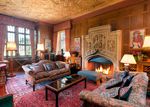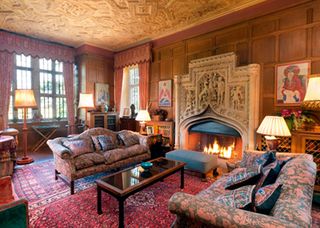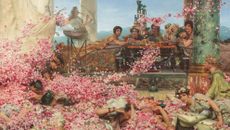Housing a modern art collection
Period houses not always the ideal backdrop for contemporary art so country house owners are devising new bespoke spaces, or properties, to house their collections


Country house owners have always wanted art to furnish their rooms, but there is an increasing new appetite for a space that can be adapted to form an art gallery that has been driven by the dramatic rise in the popularity-and prices-of contemporary art over the past two decades. A masterpiece by Anish Kapoor, Jeff Koons or Gerhard Richter is a coveted status symbol for the very affluent, but these artists didn't have traditional country-house settings in mind when they created their works, which are often really large: they envisaged the big white spaces of the contemporary public or commercial art gallery, and this can pose a challenge to private collectors.
Charlie Wells at property buyer Prime Purchase is now used to his clients asking whether a house has room for large pictures, just as they have requirements about furniture, but he remarks that ‘period houses are notoriously bad for hanging large canvasses -they tend to have lots of windows, which limits the wall space'. Philip Harvey, a partner at Property Vision, has also had several buyers over the years- from, for example, Switzerland, America and Brazil as well as from Britain-looking for country homes with large enough spaces to house their collections. ‘Most of them,' he says, ‘want the art to be visible to visitors, so look for homes with grand entrance halls, high ceilings, good light and lots of wall space'.
Guidance about the best way to install new art in old house comes from the best possible source-the artists and art dealers who have themselves invested in country houses. This has become such a phenomenon that a new word has been coined to describe this breed: the artocracy. Despite the urban and often gritty image of so much contemporary art, there is now a long history of artists buying and converting country houses to showcase their works. One of the trailblazers was the sculptor Lynn Chadwick, who, in 1958, bought Lypiatt Park, a medieval and Tudor house in a deeply romantic wooded valley near Stroud in Gloucestershire, painted the vast rooms white and installed his own sculptures.
In 2003, the house was inherited by Chadwick's sculptor son, Daniel, who is thought to have given his friend Damien Hirst the idea of buying Toddington Manor, also in Gloucestershire, a vast early-19th-century Gothic Revival mansion. Having bought the house for £3 million in 2005, Mr Hirst set about a still unfinished multi-million-pound restoration programme, intending that it should be the setting for works by him and his friends. The Cotswolds seem to have a particular appeal for cutting edge artists: Jake Chapman- who, with his brother, Dinos, is famous for sculptures on shocking and often violent themes -has settled down in the idyllic setting of a secluded farmhouse near Filkins, in Oxfordshire, which he bought in 2006.
Among the changes he made was the conversion of an adjacent barn into a full-height living room, exposing the original elm trusses and stone walls. The result recalls the sort of converted warehouse or industrial spaces in which contemporary art is now often displayed by commercial galleries, most famously Jay Jopling's White Cube. Bobby Hall, partner and head of the southern region at The Buying Solution, sees many houses with converted ancillary buildings that are, in effect, contemporary art galleries: ‘A good example is a house near Ramsbury, Wiltshire, which sold a year or two ago-it had an excellent converted barn which held an expensive art collection.'

The Quenby Hall Estate near Oakham in Leicestershire, £11m, Savills. Click on the image to go to the property details
* Subscribe to Country Life and save
Sign up for the Country Life Newsletter
Exquisite houses, the beauty of Nature, and how to get the most from your life, straight to your inbox.
These days, there is even a demand for houses that will, in effect, be only art galleries. Mark Lawson, partner and head of the Home Counties team at The Buying Solution, says: ‘I'm currently keeping an eye out for a Russian who has a large house in London as well as a country estate. He's now looking for a 30,000sq ft property in the Home Counties (close to London) to house his contemporary art collection. His London house isn't suitable, and his estate is too far out to take guests to, so he's stipulated that [the new property] also needs to be suitable to host guests for dinner.'
There can, however, be problems when it comes to selling such houses-vast white spaces don't look so good when empty, as Prime Purchase's Mr Wells recalls. ‘Years ago, a client who was selling a very contemporary house, which was almost built around his Pop Art collection, took all the art out before the house was marketed for security reasons, but this left the house looking like a clinic.'
Instead, prospective buyers can borrow some ideas from the many owners of inherited country houses who have a keen interest in contemporary art, but go out of their way to avoid that sort of art-gallery look by mixing up new and old. This isn't as easy as it sounds. At Welbeck Abbey, Nottinghamshire, William Parente found that his collection of modern and contemporary paintings and prints-which ranges from L. S. Lowry to Tracey Emin- didn't sit happily with the house's grand, mostly 18th century portraits and sporting art. ‘The handling of paint is so different', he told Country Life when his collection was shown in the estate's Harley Gallery in 2011, so he hangs his modern works separately from the house's historic collection.
However, partly by focusing on artists for whom the handling of paint is all-important, the Duke of Devonshire has found a happy way to mix Old Masters with not only portraits by Lucian Freud, but also a big abstract canvas by Sean Scully at Chatsworth.
Others, most famously the Marquess of Bute, choose works that relate to the past in less expected ways. At Mount Stuart on the Isle of Bute, he has daringly commissioned contemporary artists to create installations in historic rooms-most memorably, Langlands & Bell transformed the house's William Burges chapel by inserting a mirrored floor.
Although the intriguing phenomenon of country houses that incorporate or even look like contemporary art galleries is likely to spread, it is the juxtaposition of cutting-edge new work with the best of the past that country house owners do uniquely well.
* Follow Country Life property on Twitter
Country Life is unlike any other magazine: the only glossy weekly on the newsstand and the only magazine that has been guest-edited by HRH The King not once, but twice. It is a celebration of modern rural life and all its diverse joys and pleasures — that was first published in Queen Victoria's Diamond Jubilee year. Our eclectic mixture of witty and informative content — from the most up-to-date property news and commentary and a coveted glimpse inside some of the UK's best houses and gardens, to gardening, the arts and interior design, written by experts in their field — still cannot be found in print or online, anywhere else.
-
 How many puppies in the average litter? Country Life Quiz of the Day
How many puppies in the average litter? Country Life Quiz of the DayPlus a 1960s house, Hollywood's most famous cavewoman and more in Friday's quiz.
By Toby Keel Published
-
 Love, sex and death: Our near-universal obsession with the rose
Love, sex and death: Our near-universal obsession with the roseNo flower is more entwined with myth, religion, politics and the human form than the humble rose — and now there's a new coffee table book celebrating them in all of their glory.
By Amy de la Haye Last updated

